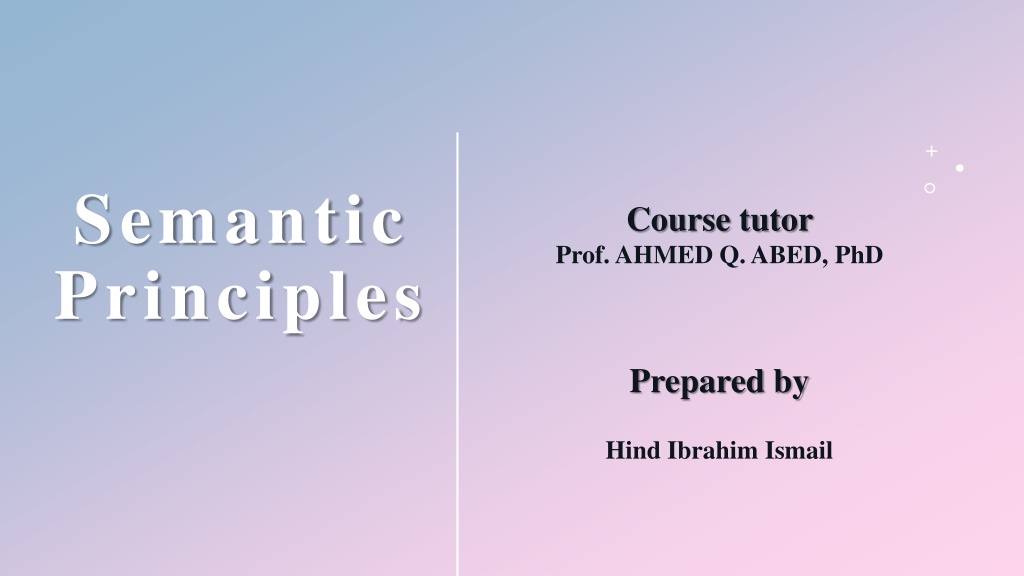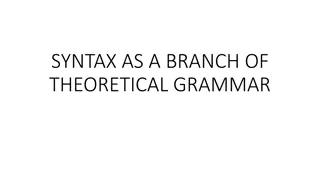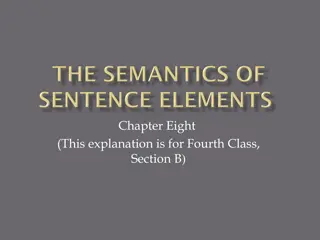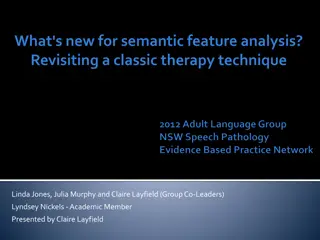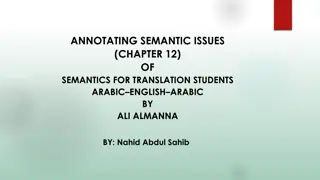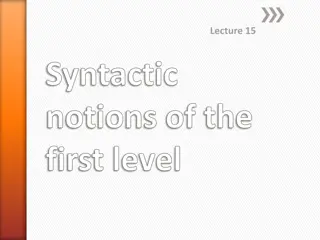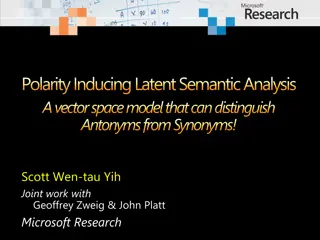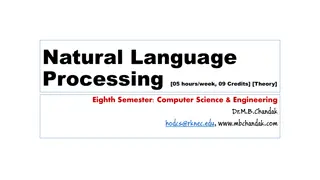Understanding Language Principles: Semantic and Syntactic Analysis
Language users rely on semantic principles like open choice and idiom to understand utterances, while syntactic analysis helps in grasping sentence structure. The interplay between lexical and phraseological features shapes language comprehension, showcasing tensions like in aspectual and idiomatic phrasal verbs. The open choice principle guides us in deciphering sentence meanings based on word arrangements, showing how syntax influences lexical choices. This comprehensive study delves into the intricate nuances of language processing.
Download Presentation

Please find below an Image/Link to download the presentation.
The content on the website is provided AS IS for your information and personal use only. It may not be sold, licensed, or shared on other websites without obtaining consent from the author. Download presentation by click this link. If you encounter any issues during the download, it is possible that the publisher has removed the file from their server.
E N D
Presentation Transcript
Semantic Principles Course tutor Prof. AHMED Q. ABED, PhD Prepared by Hind Ibrahim Ismail
Table of contents 1- Semantic principles 2- The open choice principle 3- The idiom principle
1 - Semantic principles In order to produce or understand utterances, language users rely on both lexical and phraseological features. To do so, they consciously or subconsciously follow two principles, namely the open choice principle (or terminological tendency) and the idiom principle (or phraseological tendency). At times, the lexical items have both a terminological tendency and a phraseological tendency, as in literal phrasal verbs, such as sit down, stand up, come in, put down, pick up, and so on. In this type of phrasal verbs, in which a verb is followed by a directional particle, it is not difficult to figure out their meanings because both terminological tendency and phraseological tendency are in harmony.
However, at other times, there is some sort of tension between these two tendencies, as in, for example aspectual phrasal verbs, such as take off, set up, etc., or idiomatic phrasal verbs, such as keep up, brush off, zone out, close in on, wind up, and zero in on. In these two types of phrasal verbs, especially the idiomatic phrasal verbs, the meaning of the whole phrasal verb is not related to the meanings of its constituents. Such tension has encouraged lexicographers to take into account both tendencies while designing their dictionaries. In the past, they used to focus mainly on the terminological tendency.
2 - The open choice principle A language user can sometimes elicit the meaning of the whole sentence or clause from its words and their arrangements the syntax of any language can specify the slots into which memorized items can be inserted. This principle tells us the basic restrictions on the possible choices of lexical items that can be utilized by a language user to syntactically fill in every slot identified in any given text. For example, the meaning of the sentence: My friend will travel to London next week. is compositionally driven by the meanings of its lexical items along with the grammatical markers used in the sentence:
preceded by the word next, thus functioning in the future tense indicated by the modal together as a deictic expression indicating when verb will the actor of the action will travel. My friend will travel to London next week preceded by the possessive pronoun my preceded by the preposition to, thus indicating that functions as a deictic expression the final destination of the actor referring to the speaker
To elaborate, the following example may be considered: Again, the meaning of the above sentence is compositionally driven by the meanings of its lexical items along with the grammatical markers used in it: - (scene) although it is not preceded by a definite article, such as ( (the scene of the accident (
( ( ( ( ( ( (
Paying undivided attention to the meanings of the lexical items or expressions along with the grammatical markers used in it on the one hand, and taking into account the linguistic and stylistic norms of the target language on the other, a professional translator may well suggest a rendering like this: The scene of the accident has been haunting my dreams for two years. For Sinclair (1991) , the open choice principle is: a way of seeing language as the result of a very large number of complex choices. At each point where a unit is complete (a word or a phrase or a clause), a large range of choices opens up and the only restraint is grammaticalness.
Closely related to Sinclairs open choice principle is compositionality. Compositionality means that the meaning of a word, phrase, clause, or sentence is determined by the meanings of its components (semantics) and the way they are put together to form words, phrases, clauses, or sentences (morphology and syntax). Therefore, a language user cannot understand the meaning of the following sentence unless s/he knows the meanings of its parts and the way they are ordered to form such a sentence: I have been working in this company for ten years. (The year of uttering the sentence is 2016) I:the actor referring to the speaker; the pronoun I does not indicate the speaker s gender, age, etc., but we can guess that his/her age is over twenty-eight.
have been working : work means to do a job that needs a physical or mental effort in order to earn money. From its position in the sentence, it is a verb in the continuous perfect tense, so the aspect is perfect progressive, emphasizing that the speaker started working in the company in 2006 and is still working at the moment of uttering his/her sentence. in this company: companymeans a business organization selling goods or services. The demonstrative pronoun this along with the preposition in means that the speaker works in the company that has been mentioned earlier by him/her or by the addressee, or it might be the place of uttering his/her sentence. for ten years: covering the whole period from 2006 up to 2016.
Giving full consideration to the meanings of the parts of the above sentence and the way they are ordered to form such a sentence on the one hand, and paying extra attention to the linguistic and stylistic norms of the target language on the other, a well-trained translator may suggest a translation like this: . Or .
3 - The idiom principle The idiom principle, however, posits that a language user has available to him or her a large number of semi-preconstructed phrases that constitute single choices, even though they might appear to be analysable into segments . For example, the word cheese has a relationship with words like butter, milk, yogurt, and so on as they all parts of dairy products. Therefore, in a sentence like this: some cheese some butter some milk I will have for breakfast. some eggs a cup of coffee a cup of tea
a native speaker expects expressions like some cheese, some butter, and the like to syntactically fill in the slot identified in the above sentence. Such a principle is known as slot-and-filler ,as it tells the reader/listener the basic restrictions on the possible choices of lexical items that can be utilized by a language user to syntactically fill in every slot identified in any given text. However, the same word cheese in a sentence like this: It seems that his brother is a big cheese in one of the major companies in the country. cannot be replaced with one of the expected words/expressions above as the word cheese in the idiomatic expression a big cheese refers to an important or powerful person in a group or organization. The same holds true for lexical items like butter and milk in these two sentences: This is your grade in the exam, so don t try to butter me up. You have to do your best if you don t like your presentation to be just milk and water.
In the first example, to butter upmeans to treat somebody nicely in hopes of receiving special favours. As for the second example, milk and water means weak or feeble. Therefore, the meanings of to butter up and milk and water are not related directly to the denotative meanings of their receptive constituents, that is, butter + up and milk + water. Similarly, when you hear somebody saying: At the beginning of an exam, I always have butterflies in my stomach. most English speakers will recognize that s/he does not mean literally to have butterflies in his/her stomach, but rather, it means s/he is very nervous or worried. The phrase to have butterflies in one s stomach, then, is not compositional since its overall meaning, that is, to be nervous or worried, does not derive from the meanings of its components.
References 1 Almanna, Ali (2016). Semantics for Translation Students : Arabic English Arabic. United Kingdom: Peter Lang Ltd, International Academic Publishers
